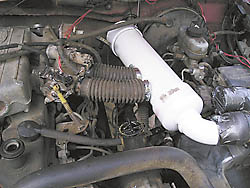
A 50 percent increase in mileage saved Mike Toppen a lot of money over several years, and will soon be saving him even more thanks to today's record fuel prices. He says his homemade fuel extender uses air movement to get more complete vaporization of fuel.
"It's a matter of giving the fuel time to vaporize. I increase the length of time the fuel mixes with air before it goes into the engine," explains Toppen. "I went from 13 mpg on my '93 Ford half-ton pickup to 19."
Toppen's device consists of a 2-in. pvc pipe inside a 4-in. pvc pipe. He mounted a fuel injector inside the inner pipe. The pipe is also hooked to the air intake system. The fuel line is plumbed to a port on the main fuel rail on the motor, with the entire system mounted between the air cleaner and the carburetor.
Toppen set the system up so once the gas pedal/throttle is depressed to a certain point, the line opens and fuel is pulled from the main line to be directed through the device. A dial mounted on the dash lets him adjust the amount of fuel that passes through the device based on in-town (less) or open-road (more) driving.
A series of fins creates turbulence as the air moves through the tube. When it gets to the end of the tube, it passes into the second tube and reverses direction, passing across a second set of fins. This creates still more turbulence, which Toppen credits for the enhanced vaporization.
"I don't know if the spins caused by the fins were necessary, but it worked," says Toppen. He recently sold his pickup with the device and is in the process of building a new system he hopes will work even better. He's willing to put together detailed plans for his fuel device if there's enough interest.
